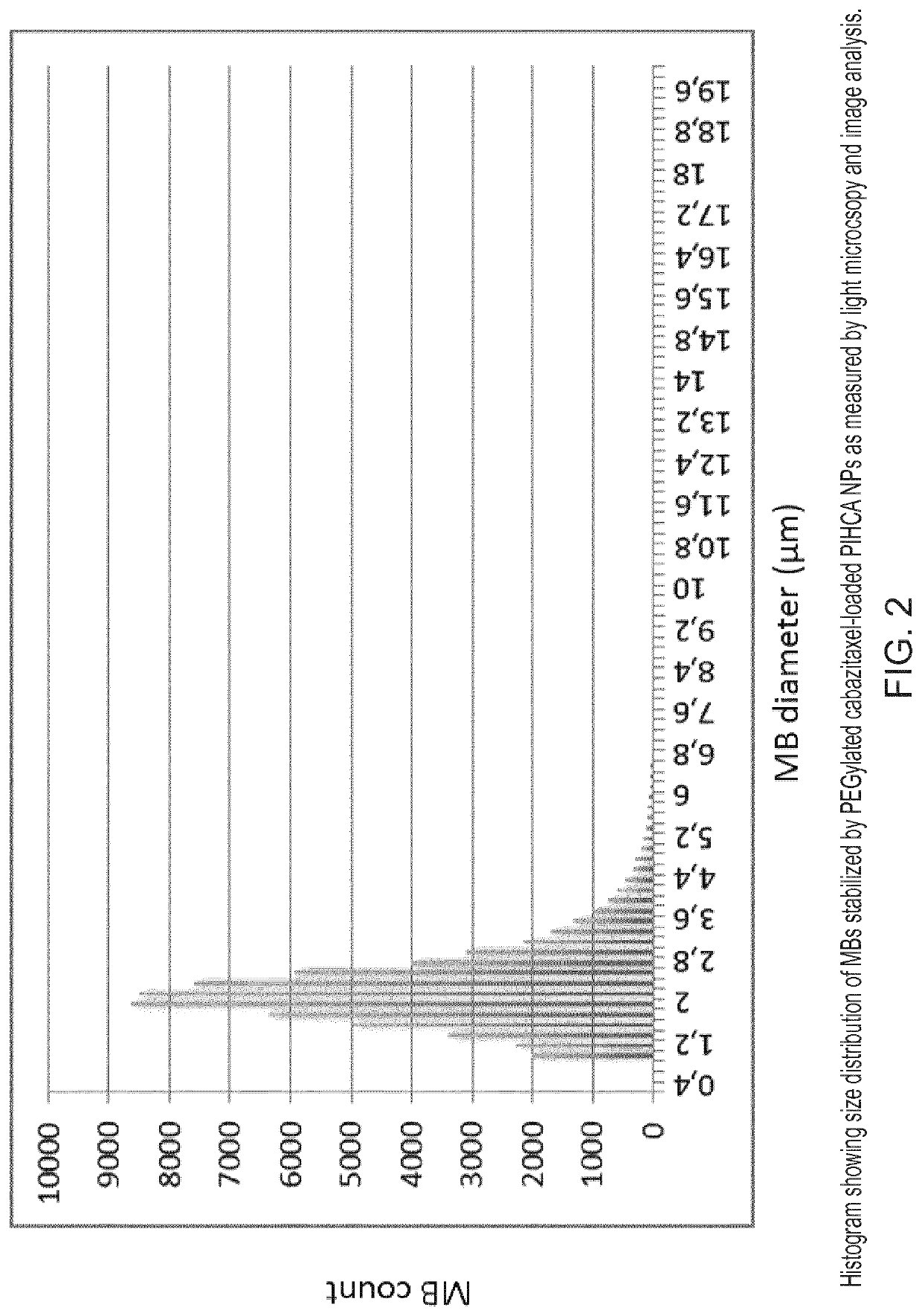A new drug delivery system for treatment of disease
- Summary
- Abstract
- Description
- Claims
- Application Information
AI Technical Summary
Benefits of technology
Problems solved by technology
Method used
Image
Examples
example 1
[0195]Production of Drug-Loaded PACA NPs and NP-Stabilized Microbubbles
[0196]Materials and Methods:
[0197]Synthesis and Physico-Chemical Characterization of Drug Loaded PACA NPs:
[0198]PEG-coated and cabazitaxel-loaded PIHCA NPs were prepared by the miniemulsion method as follows: An oil phase containing 1.50 g of isohexyl cyanoacrylate (monomer), 0.03 g of Miglyol 812 (co-stabilizer, inactive oil) and 0.18 g cabazitaxel (cytotoxic drug) was prepared by thorough mixing in a glass vial. An aqueous phase containing 0.09 g of Brij L23 (23 PEG units, MW 1225) and 0.09 g of Kolliphor HS15 (15 PEG units, MW 960), dissolved in 12 ml of 0.1 M HCl was prepared. An oil-in-water emulsion was prepared by mixing the oil and aqueous phase and immediately sonicating the mixture (Branson digital sonifier 450) on ice for 2 minutes (4×30 sec intervals, 60% amplitude) followed by another 3 minutes (6×30 sec intervals, 30% amplitude). After sonication the solution was rotated at 15 rpm overnight at room ...
example 2
[0207]Cellular uptake of fluorescent dye (“model drug”) encapsulated in nanoparticles (PIHCA) in breast cancer cells.
[0208]The aim of this study was to investigate the mechanisms of ultrasound-mediated delivery, to determine whether stable or inertial cavitation is the major mechanism for improved extravasation and enhanced NP delivery. To achieve successful delivery, the NPs have to circulate in blood for sufficient amount of time, extravasate from the vasculature, penetrate the extracellular matrix and deliver their payload to the intracellular targets.
[0209]Size and zetapotential of the biocompatible and biodegradable poly(isohexyl cyanoacrylate) NPs were determined by Zetasizer. In vitro cellular uptake was studied in breast cancer cells (MDA-MB-231) using confocal laser scanning microscopy (CLSM) and flow cytometry (FCM) by encapsulating a fluorescent dye.
[0210]FIG. 4 shows that the size and zetapotential of the NPs were approximately 170 nm and −1 mV, respectively. Cellular up...
example 3
[0240]Uptake of drug in cells and cytotoxicity of empty and drug-loaded PACA NPs
[0241]Measuring the drug release intracellularly is necessary in order to understand the effect on cancer cells after internalization. The inventors used the model drug NR668 (modified Nile Red) encapsulated in poly (butyl cyanoacrylate) (PBCA) and poly (octyl cyanoacrylate) (POCA) to demonstrate that the NPs have different drug release kinetics also after internalization. While ordinary fluorescence imaging gives little information about the degradation, Fluorescence lifetime imaging (FLIM) (as shown in FIG. 12), Förster resonance energy transfer (FRET), emission specter analysis and time-laps imaging after cell lysis provids valuable information.
[0242]FIG. 13 demonstrate the cellular uptake of NPs in breast cancer cells.
[0243]The cytotoxic effect of empty PBCA NPs, PBCA NPs with encapsulated cabazitaxel as well as free cabazitaxel was studied on breast cancer cells (MDA-MB-231 cells=human epithelial, m...
PUM
| Property | Measurement | Unit |
|---|---|---|
| Time | aaaaa | aaaaa |
| Diameter | aaaaa | aaaaa |
| Surface | aaaaa | aaaaa |
Abstract
Description
Claims
Application Information
 Login to View More
Login to View More - R&D
- Intellectual Property
- Life Sciences
- Materials
- Tech Scout
- Unparalleled Data Quality
- Higher Quality Content
- 60% Fewer Hallucinations
Browse by: Latest US Patents, China's latest patents, Technical Efficacy Thesaurus, Application Domain, Technology Topic, Popular Technical Reports.
© 2025 PatSnap. All rights reserved.Legal|Privacy policy|Modern Slavery Act Transparency Statement|Sitemap|About US| Contact US: help@patsnap.com



